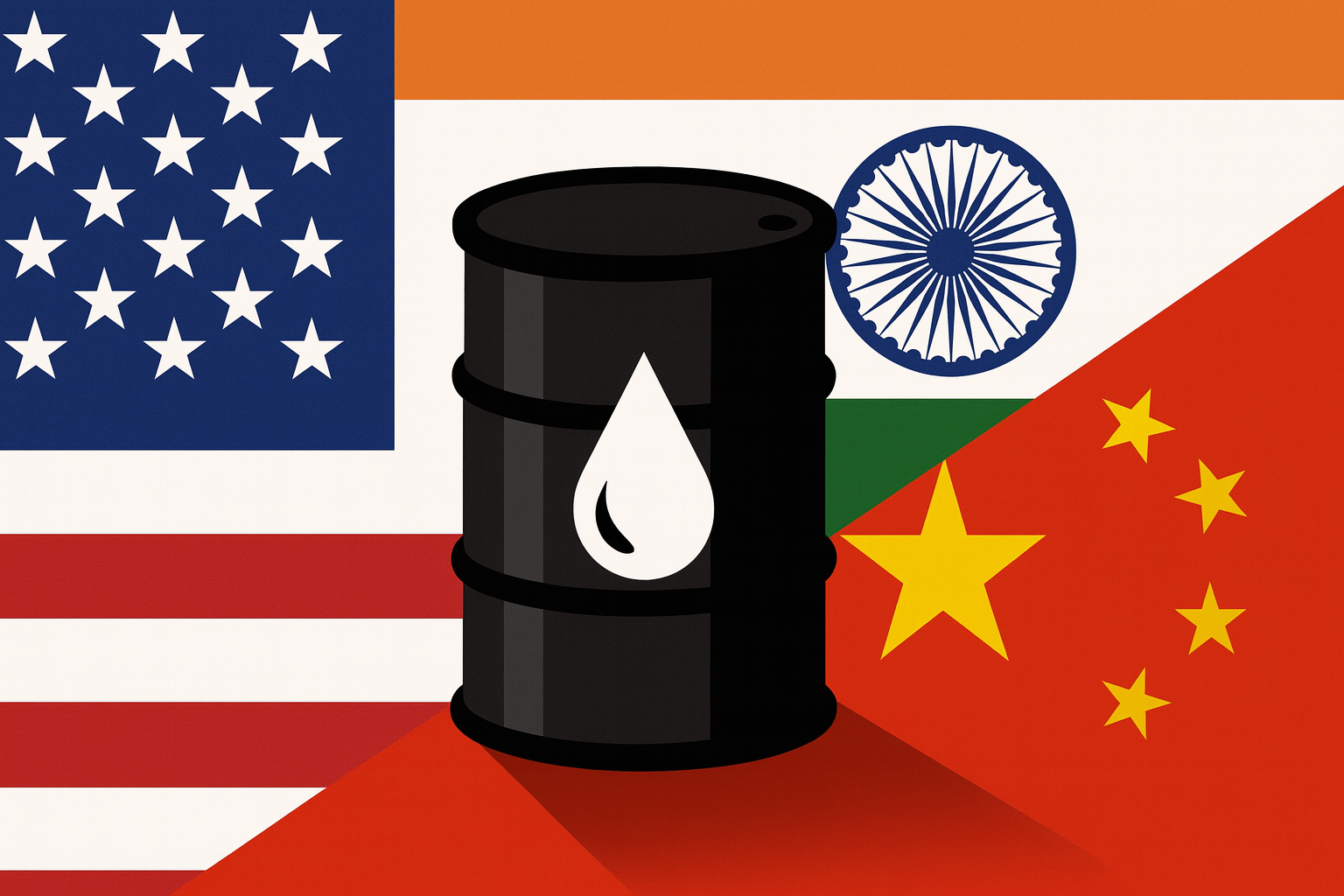Trump Doubles India Tariffs Over Russian Oil Purchases, Extends China Trade Truce in Economic Warfare Escalation

Intelligence Summary
In August 2025, the United States, under President Donald Trump, initiated a significant escalation in its use of tariffs and sanctions as instruments of great power competition, targeting both adversaries and strategic partners. A notable move was the imposition of doubled tariffs on India, specifically in response to India’s continued purchases of Russian oil. President Trump publicly claimed responsibility for these measures, stating, “We’re sending a message to every country that funds Putin’s war machine: there will be consequences”. The new tariffs have immediate and far-reaching effects on India’s economy, particularly its diamond industry, which is the world’s largest supplier and now faces potential shutdowns due to increased costs and disrupted supply chains. Indian officials have responded by expanding bans on certain imports, signaling a willingness to retaliate and recalibrate their own trade policies.
The United States’ approach is not limited to India. Washington is actively pressuring all major buyers of Russian oil, including China and Turkey, and is expanding the scope of secondary sanctions. These measures are designed to target not only direct transactions with Russia but also third-party countries and companies that facilitate Russian energy exports. The US has also implemented parallel export controls and sanction measures, affecting allies in both Europe and Asia. The impact of these policies is already being felt in global supply chains, with reports of cascading disruptions in sectors ranging from energy to manufacturing.
Despite the aggressive posture toward India and other Russian oil buyers, the US approach to China is more nuanced. While some tariffs on Chinese goods remain in place or are being tweaked, President Trump has extended a 90-day tariff truce with China, delaying the implementation of new reciprocal tariffs. This move was confirmed by official statements from both US and Chinese trade representatives on August 12, 2025, who cited ongoing negotiations and the need to “avoid unnecessary escalation”. At the same time, the US has opted to collect revenue from advanced computer chip sales to China, rather than imposing a total ban on advanced semiconductor exports. Under a new arrangement, US companies such as Nvidia and AMD are permitted to sell certain chips to Chinese firms in exchange for a 15% revenue share with the US government. This policy shift was announced on August 12, 2025, and is seen as a pragmatic compromise that balances economic interests with strategic concerns.
China has responded to these developments by urging its domestic tech giants to avoid purchasing Nvidia’s H20 chips, even after the US lifted the sales ban. Chinese officials have raised concerns about the security and reliability of US-made semiconductors, and there are reports of Beijing encouraging local firms to accelerate the development of indigenous alternatives.
Other countries are also adjusting their trade policies in response to the shifting US stance. South Africa has revised its trade agreement with the US, and Syria is seeking new energy infrastructure options amid regional power struggles.
The impact of US tariffs and sanctions is evident in rising power bills and inflation within the nation itself. This is exemplified in the state of Maryland, as polling data for Governor Wes Moore has plummeted amid public frustration over energy costs.
Why it Matters
The escalation of US tariffs and sanctions in August 2025 emphasizes the evolution of economic statecraft as a tool of great power competition. By targeting India, a key strategic partner and the world’s largest diamond supplier, for its continued purchases of Russian oil, the US is signaling a willingness to subordinate traditional alliance management to the imperatives of economic warfare against Russia. This move not only strains US-India relations but also sends a clear message to other major Russian oil buyers, such as China and Turkey, that Washington is prepared to use its economic leverage even at the risk of alienating important partners.
The doubling of tariffs on Indian goods has immediate consequences for global supply chains, particularly in the sectors of diamonds and energy. The potential shutdown of India’s diamond industry, as reported by industry leaders, could disrupt global markets and force companies to seek alternative suppliers, with ripple effects across multiple economies.
India’s decision to expand bans on certain imports in response to US tariffs demonstrates the risk of tit-for-tat escalation and the potential for a broader trade war that could undermine global economic stability.
The US strategy of expanding secondary sanctions and export controls represents a significant escalation in the use of economic tools to achieve geopolitical objectives. By targeting direct transactions with Russia as well as nations involved with Russia, the US is effectively weaponizing the global financial system and supply chains. This approach increases the risk of global economic fragmentation, as countries may seek to insulate themselves from US pressure by developing alternative payment systems, supply chains, and trade networks.
The US approach to China illustrates the complexity of competition in the economic domain. While maintaining pressure through tariffs and export controls, the US has opted for selective engagement, extending a 90-day tariff truce and allowing computer chip sales in exchange for a revenue share. This pragmatic approach reflects the interdependence of the US and Chinese economies, particularly in high-tech sectors, and the difficulty of pursuing a total decoupling without incurring significant costs. China responded to this by urging domestic firms to avoid US chips and accelerating the development of indigenous alternatives, highlighting the ongoing technological rivalry and the potential for a bifurcation of global technology standards.
The broader geopolitical implications of these developments are significant. The US use of tariffs and sanctions as primary tools of statecraft risks undermining the cohesion of traditional alliances, leading to partners like India and South Africa recalibrating their policies in response to perceived US overreach. The expansion of secondary sanctions and export controls could accelerate the fragmentation of the global economy, as countries seek to reduce their vulnerability to US pressure. The selective engagement with China, while avoiding immediate escalation, leaves unresolved the underlying structural tensions in the US-China relationship.
The impact of the US international economic policies is evident domestically as well, as seen in rising energy costs and declining approval ratings for local officials. This highlights the potential for economic statecraft to generate unintended consequences at home as well as abroad.
In sum, the US escalation of tariffs and sanctions in August 2025 represents a significant intensification of competition in the economic domain.There is a clear pattern of the US leveraging its economic and regulatory power to influence the behavior of both adversaries and allies. The US use of tariffs, secondary sanctions, export controls, and selective engagement with China reflects a complex and evolving strategy aimed at reshaping global energy flows, supply chains, and the balance of power in the international system. This escalation has far-reaching implications for energy security, supply chains, alliance management, and the future of the international order.
Key Actors
- United States (President Donald Trump, US trade and treasury officials)
- India (Indian government, diamond industry leaders)
- China (Chinese government, domestic tech firms)
- Russia (as the target of sanctions and oil trade restrictions)
- Turkey (as a major Russian oil buyer)
- South Africa (trade policy adjustments)
- Syria (energy infrastructure and regional power dynamics)

